Buying an acoustic guitar isn’t an easy task, especially if you are a beginner and don’t have a clue what differentiates a good music instrument from a bad one. Buying an acoustic guitar that doesn’t suit you or your playstyle won’t do you any good. Especially if later on you will find out that you struggle with it as you play.
Buying a bad electric guitar isn’t the same as buying a bad acoustic guitar. Electric guitars are quite “forgiving” in that area because you can always set it up properly, or change the pickups or the amp if you don’t like the tone. However, an acoustic guitar is a different case. If you have bad intonations or extreme high string action, it will be hard and almost impossible to fix. Not to mention, if you suddenly dislike the tone of your guitar.
Your Budget

Define the budget available to you that you can spend on an acoustic guitar. Playing guitar is like any other hobby and it will cost some money. Of course, you don’t have to buy the most expensive acoustic guitar just to start learning. There are plenty of great acoustic guitar options for $200 – $300.
If you already have an acoustic guitar or played mainly electric and wish to learn and expand your skills on an acoustic guitar as well I would recommend not going for a beginner’s guitar budget. You already know what you like, what tone, what style, just go with your guts. Don’t settle on another beginner’s guitar just because it looks better. If you can’t afford a bigger budget wait a bit and save some more. It is better to have one awesome guitar instead of a dozen beginner’s guitars.
Variations
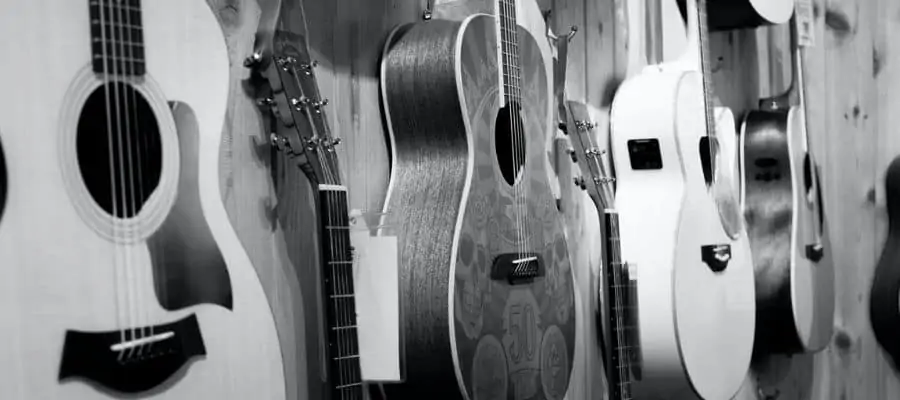
If you want to find the best possible guitar for you you need to try as many guitars as possible. I know that online shopping is super convenient that you just don’t feel like getting out and trying. But, this is super important, especially for beginners.
You need to visit several guitar dealers in your local area. It is common to see that a music shop keeps in stock just several brands that they work with, while other shops may work with other brands. Try different brands, models, sizes, shapes, and try to find several guitars that you like, and then narrow down your selection based on the points listed in this article.
If you insist on buying the guitar online, find several guitars that you think are suited for you. I would recommend watching a lot of reviews and comparisons of those specific guitars you are interested in and that are within the budget. And buying from a reliable online store like Sweetwater, Amazon, Thomannmusic, etc.
Trusted Seller And Brand
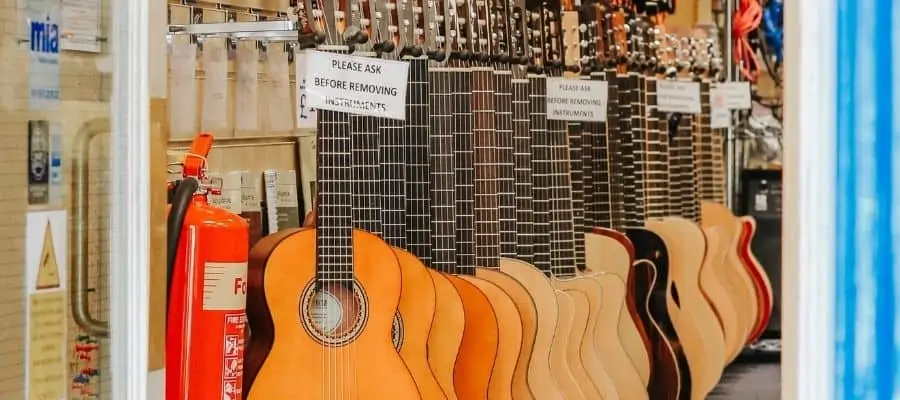
When buying a guitar you should stick to a brand that is well trusted and well-known. It isn’t just the brand but the model itself as well. Make sure that the model you are interested in has positive reviews online or any reviews at all.
You don’t want to end up buying some unknown Chinese guitar that will start breaking down after a week of playing. It isn’t like there are excellent Chinese manufacturers that make great guitars. But, if you haven’t heard of the brand and having a hard time finding it online, you are taking a gamble with the instrument you are buying.
The second thing you want to make sure you are buying from a respectable dealer. Someone that has good customer service and a dedicated music instrument shop that has been around for some time in case there is something wrong with the guitar.
Body Shape & Size

Acoustic guitars come in various shapes and sizes. The last thing you want to do is to buy the wrong size or shape for you. Learning to play guitar is a challenge in itself and you don’t want to struggle with your instrument as you learn. The guitar should feel as much comfortable as possible to you when you play it.
Acoustic guitars come in various sizes and shapes: the parlor being the smallest then the concert, dreadnought, and jumbo. Of course, there are several more types but these are the most common. Out of all the body shapes, the dreadnought is the most common.
Different body shapes offer different sound characteristics. However, this won’t be any good if you can’t play this guitar freely.
When testing the various guitars make sure you can reach the strings with your right hand and you can reach the headstock with your left hand. Make sure you are comfortable with the neck size and you can fully and easily form chords.
If you are a total beginner bring someone with you. Whatever it is your guitar teacher or a friend, you need to bring someone that you trust to test the things you still can’t or don’t know how to.
Neck
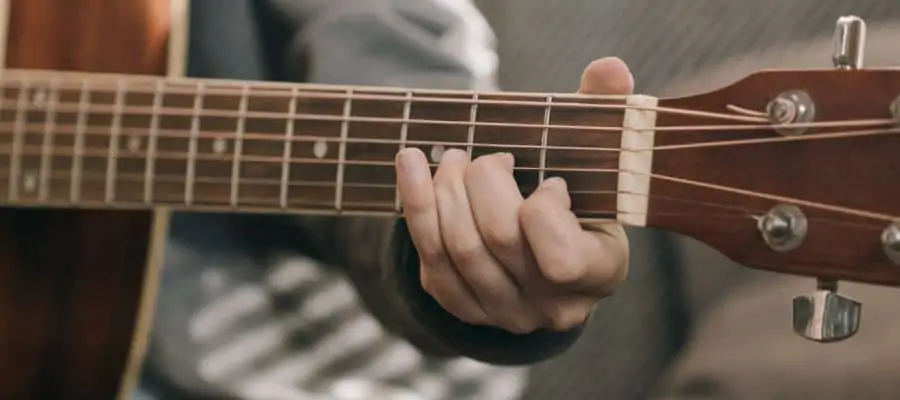
When choosing an acoustic guitar you should consider the neck in terms of comfort and playstyle. The key to finding the neck profile that suits you is to keep on testing as many guitars as possible.
As far as the playstyle goes necks with a wider is usually suited for more fingerstyle playing. Whereas necks with a thinner nut are more comfortable for chords and strumming. If you don’t have a clue what style you prefer or what you want to play more try going for something in the middle that can be suited for both.
Fretboard

On acoustic guitars, there are usually two types of fretboard materials available: rosewood and ebony. Of course, there aren’t only two selections, each type of wood has different species like cocobolo, Indian, Brazilian, etc. Each species offers a different texture, color, and feeling to the fretboard
However, the main difference between ebony and rosewood is that ebony is smooth and rosewood is rough. It doesn’t mean that ebony is better than rosewood, just a different preference. Also, ebony is a bit more pricey and usually found on a more expensive acoustic guitar.
Tonewood
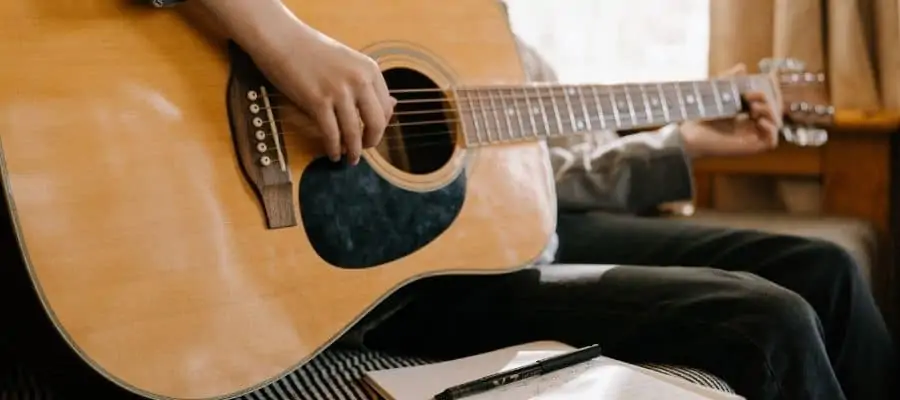
The tonewoods of an acoustic guitar are one of the main factors that determine the sound of the guitar. Each tonewood offers a different sound. Hearing and pointing out the exact difference between each of the tonewoods can be challenging, especially for beginners among you.

Don’t worry if you can’t. In time as you are exposed to more music you will start noticing those differences naturally.
Construction
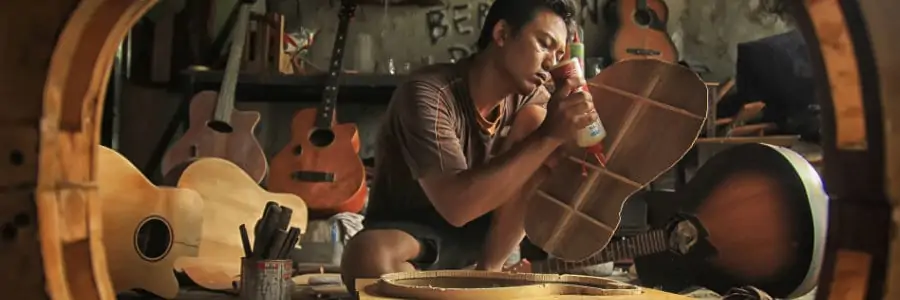
Construction is another thing that affects the tone. There are several types of constructions when it comes to the acoustic guitar: solid wood, laminated wood, the combination of the two.
When it comes to the difference between those two, solid wood sounds far more superior to laminated wood. As a result, the price is much higher as it is harder to work with. On the opposite side, the laminated wood is much cheaper and easier to work with, this is why it can be found mostly on beginner’s guitars.
As a way to compromise between the construction time, price, and the sound of the guitar a lot of manufacturers combined the two. Those guitars would be constructed with solid wood tops and the rest of the guitar is made of laminated wood.
The reason to make the top from solid wood and not the back is that it is usually thinner. Also, the guitar’s top has a huge contribution to the sound of the guitar. Because the sound bounces around the body eventually leaving through the top of the guitar as the soundhole is located there.
So if you are in the look for an acoustic guitar and tight on the budget, get yourself a guitar with a solid top as it will have a much richer tone compared to all laminated constructed guitars.
String Action

String action is the term used to describe the string high from the frets. Usually, it is measured with a special ruler. But, you can see or feel if the action is too exaggerated. Each manufacturer and guitar has its own standard for what is considered the baseline for a correct string action. It is usually between 5/64” (2.0 mm) to 8/64” (3.175 mm).
The string action is determined by two things, the neck, and the bridge. Incorrect string action can be corrected by adjusting the truss road and the saddle. It can be fixed only to a small amount of deviation.
When buying a new guitar, even if it is a good quality one you want to ask for an overall setup. Sometimes a good setup can make a huge difference in the comfort and sound of the instrument.
However, when buying a second-hand guitar this issue may be more common. So you want to double and triple-check that the action is in the normal range and it is changeable as well. In other words, that the guitar truss rod isn’t maxed or the bridge isn’t coming off.
Sharp Fret Edges
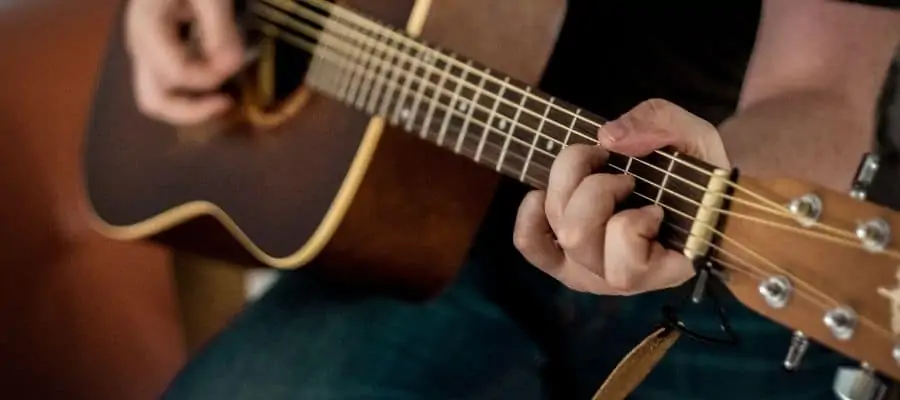
As for the frets you want to check a couple of things. The first thing is the edges of the frets. When moving your hand across the neck you want to make sure there aren’t any sharp edges. Basically, you shouldn’t feel them at all at the bottom or at the top of the fretboard.
Frets that have sharp edges indicate a poorly manufactured guitar. They are quite common on beginner’s guitars and unknown brands guitars. On the other hand, on the top higher-end guitars you may even see rounded fret edges. This just indicates the amount of time spent making this instrument as rounding the fret edges takes time.
I would advise avoiding guitars with sharp edges altogether. But, if you found a guitar you really like at the shop you can ask the seller to check if they have the same guitar at the storage without this issue. I wouldn’t disqualify the whole brand or model type just because of this issue. It can probably be just this specific guitar.
Flat Frets

The second thing you want to check is whatever the frets are leveled across the neck. Of course, this isn’t an easy task because these things are done with a special tool (fret rocker). But, there are few things that you can do without any special tools.
You want to look for frets that are sticking way too much out of the fretboard or frets with a flat surface. Frets that stick out of the fretboard indicate a poorly constructed instrument. Frets with a flat surface can indicate two things. First, extensive usage is common on used instruments. Second, the manufacturer forgot to crown(round up) the frets after leveling them, which is highly irregular.
Another test you can perform is string buzzing or string choking. You can check for string buzzing by going across all the fingerboard positions and playing each and every position on every string and listening carefully for a buzz. As for string choking, it is a similar test to string buzzing. But instead of just picking the string you need also to bend it. If the string chocks, you will hear that it silenced right after you bend it.
As with the sharp edges, I would advise moving to another guitar as fixing those things can be costly and discouraging from playing. It just sucks to play guitar with these issues, believe me, I have been there.
Tuning Stability
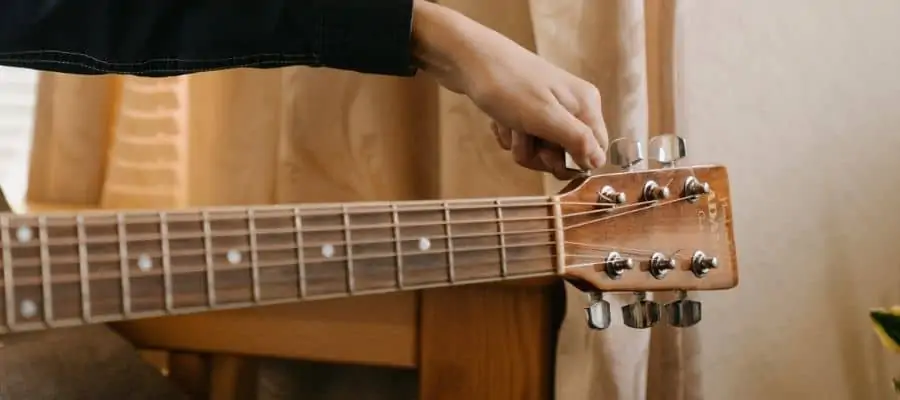
Tuning stability is quite important. The last thing you want to do while playing your guitar is retuning it every few minutes. Retuning the guitar while practicing isn’t a big deal, but think if it would happen while performing.
If you just put a set of new strings on your guitar you will notice it will go out of tune quite often, and it is pretty common. To help your new strings “break-in” (stabilize) you can pull them away several times at different positions across the fretboard.
Good tuning stability is one that keeps its original tuning for at least a whole practice session when the strings are broke-in (stabilized). Of course, if you are going to practice for nine hours you may experience that your guitar goes out of tune. But for a one-hour practice, the tuning should hold. As a rule of thumb, you want to tune the guitar before you start playing.
When purchasing an acoustic guitar you want to check if the tuning machines are stable, firm, aren’t slipping, and overall good quality ones. In order to check if they’re of good quality, you want to play this guitar for quite some time to hear if the chords you are playing starts to sound strange. If you aren’t experienced enough, you can just check with the tuner if the tuning is the same as you began playing it.
Also, you want to watch out for strings slipping while tuning, as this will indicate a low-quality tuning machine. You can do this by detuning and tuning again the guitar and see if a string loses its tension while winding up the strings.
Accurate Intonation
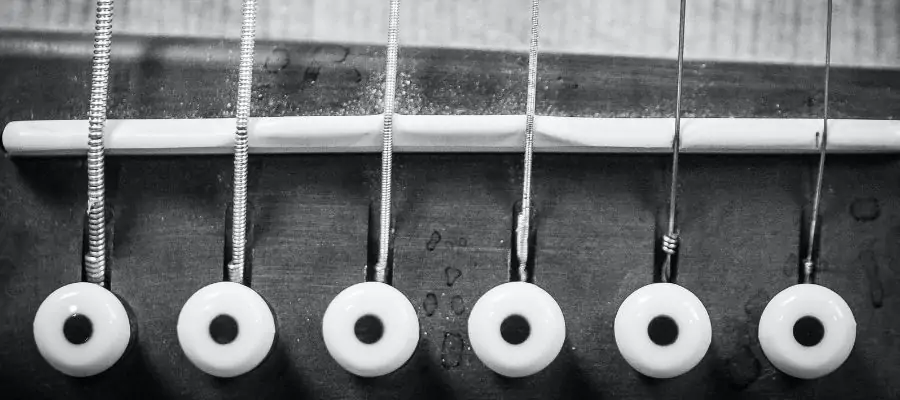
Guitar intonation is how the guitar stays in tune with itself along the fretboard. When playing guitar with inaccurate intonation the chords or notes will sound out of tune as you move up the neck. Guitar intonation can be inaccurate even if the open strings are perfectly in tune.
The proper way to check for an accurate intonation is first tuning the guitar to the standard tuning. Then you want to go over all the strings and play a harmonic on the 12th fret. When playing the 12th fret harmonic you are playing the same as an open string but one octave higher. The thing you want to check is whatever on the tuner the 12th fret harmonic and an open string displays the same.
If the 12th fret harmonic doesn’t match slightly the tuning of an open string it can be fixed easily. However, If there is a semitone difference or more it will be even more work that only a luthier can perform which can be costly. That’s why I would recommend avoiding guitars like that.
it is harder to fix inaccurate intonation on acoustic guitars, unlike electric guitars. As the part that determines the accuracy of the intonation is the saddle. On an electric guitar, it is easily adjustable but, on an acoustic guitar, it is fixed on the bridge. Despite that, you can fix some inaccuracy in the intonation by carefully sanding the saddle a bit to reposition the end of the string to where you want to. But it is very limited as the saddle is only about 1/8″ thick.
Pickups

You need to ask yourself several questions: Do you need a pickup on your guitar? Are you going to perform with your acoustic guitar? Are you going to plug it into an amp?
Having a pickup on your acoustic guitar is always nice, but it has an extra cost to it. So, If you are a beginner and this is your first guitar I would recommend you to avoid this option and get yourself a guitar without a pickup.
For those of you who are interested in gigging or even in recording yourself, getting a guitar with a pickup is a must. Micing an acoustic guitar on a gig can be a nightmare as you won’t be able to move while performing.
If you have decided that you need a pickup in your guitar, you just need to consider which type of pickup you like more. You have several types of acoustic pickups available to choose from magnetic soundhole pickups, transducer pickups, internal microphones, and piezo which is the most common one.
Appealing Look
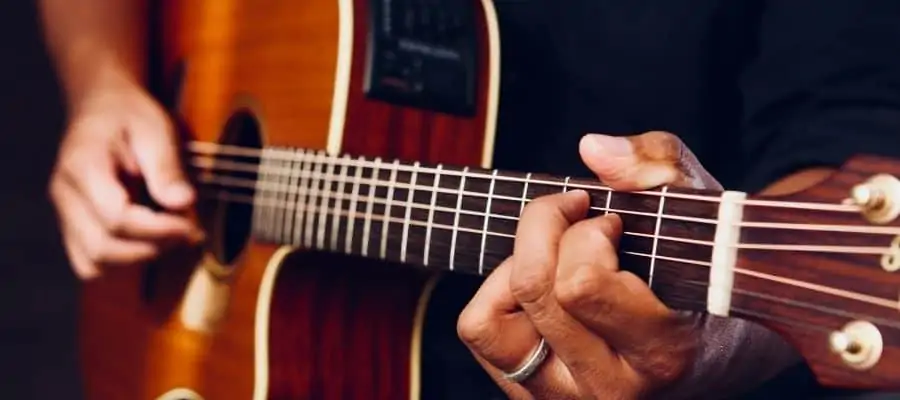
There is a reason why this is the last thing on the list as this is the least important thing you should consider when getting an acoustic guitar. You shouldn’t be distracted by some bizarre color or cool painting. In fact, those things can be sometimes found on a cheaper on poorly constructed guitar as it will try to hide all its flaws.
Having said that, a great-looking guitar to your taste is always better than one you don’t like. You should find something you enjoy looking at and find appealing to your taste but only after you checked all the above items on the list.
A good-looking guitar adds to the satisfaction of the instrument. You will enjoy taking it out from its gig bag and you will be more eager to play. Thus, practicing more often.
Conclusion
Getting an acoustic guitar isn’t an easy task. But when breaking it down to a checklist it can be easier to choose the right one for you. One of the most important things in getting the right acoustic guitar for you is to play as many as possible. I can’t stress enough how important it is.
Another important thing is to bring someone with you. If you are an inexperienced player you won’t be able to test everything, and that’s OK. Try bringing your friend, guitar teacher, someone that knows at least a bit about guitars. But even if you bring someone that doesn’t it is still a good thing. It is always good to hear another opinion.
If you found this article useful, you may want to save this pin below to your Guitar board.

Recent Posts
Some guitarists insist on buying an expensive amplifier with their electric guitar. They assume that this is a must for every type of guitarist out there. However, in some situations, this isn’t...
Top 50 Free Realistic Guitar VST Plugins With Sound Examples
As technology has rapidly advanced in the recent decade, computers are stealing more and more roles from physical musical instruments and accessories. Nowadays, you do not need expensive amps,...

